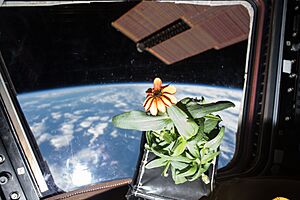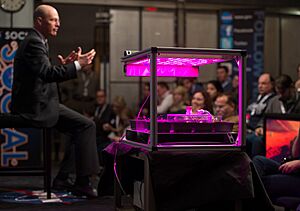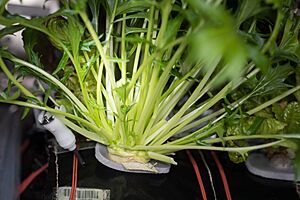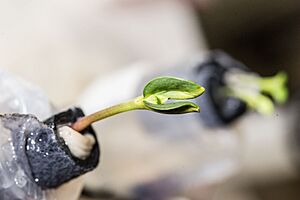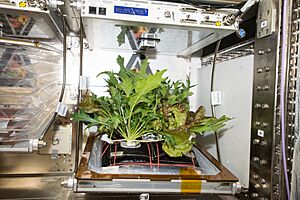Plants in space facts for kids
Have you ever wondered if plants can grow without gravity? Scientists have been fascinated by this question and have been trying to grow plants in outer space for many years. These "space gardens" are not just for fun. They are an important part of planning long space missions to the Moon or Mars.
Growing plants in space is important for several reasons. They can:
- Provide fresh food for astronauts.
- Produce the oxygen they need to breathe by absorbing carbon dioxide.
- Help control the humidity inside a spacecraft.
- Make astronauts feel happier and more connected to Earth on long journeys.
The first big challenge is figuring out how to grow plants in a weightless environment. Scientists have been doing experiments to solve these problems for decades.
Contents
Challenges of Space Gardening
Growing plants on Earth seems simple, but in space, it's a whole different story. The biggest challenge is the lack of gravity, which causes a few problems.
- Confused Roots: On Earth, roots naturally grow downwards, pulled by gravity, to find water and nutrients. In space, roots can get confused and grow in all directions.
- Watering is Tricky: Without gravity, water doesn't flow down into the soil. It can float around in bubbles, making it hard to get the right amount to the plant's roots. Scientists have to design special watering systems.
- Special Lights are Needed: Plants need sunlight to grow through a process called photosynthesis. Inside a spacecraft, scientists use special LED lights that provide the right colors and brightness for plants to grow strong and healthy.
A History of Space Gardens
Humans have been sending plants to space for almost as long as they have been sending rockets.
The First Seeds in Space
The journey of plants in space began in 1946, when the United States launched the very first seeds—maize (corn)—on a V-2 rocket. These early experiments were to see how space travel affected seeds.
A famous experiment happened in 1971 during the Apollo 14 mission. Astronauts took about 500 tree seeds on a trip around the Moon. When they returned to Earth, these "Moon trees" were planted across the United States. They grew up to be healthy trees, showing that their trip to space didn't harm them.
Gardens on Space Stations
When astronauts started living on space stations for long periods, growing plants became even more important.
In 1982, on the Soviet Salyut 7 space station, a small plant called Arabidopsis became the first plant to flower and produce seeds completely in space. This was a huge success because it proved that plants could complete their entire life cycle in a weightless environment.
Later, on space stations like Mir and the International Space Station (ISS), many more experiments took place. Scientists built special greenhouses, like the Russian SVET-2 and the American "Veggie" system.
A very exciting moment happened on August 10, 2015. American astronauts on the ISS got to eat something they had grown themselves: red Romaine lettuce. Since then, astronauts have grown and eaten different kinds of vegetables, like cabbage and mizuna. They have also grown beautiful flowers, like sunflowers and zinnias, bringing a splash of color and life to the space station.
Famous Experiments and Discoveries
Scientists have conducted many clever experiments to understand how plants behave in space.
- Do plants have an internal clock? In 1983, scientists sent sunflower seedlings into orbit. They noticed that even without gravity, the seedlings still made small circular movements as they grew. This showed that some plant behaviors are built-in, like an instinct.
- Can plants still sense gravity? In experiments on the ISS, scientists grew lentil seedlings in a special machine that could create different levels of gravity. They discovered that plants are so sensitive they can tell which way is "down" even with very little gravity.
The First Plant on the Moon
In January 2019, China's Chang'e 4 lander carried a tiny, sealed container called a "biosphere" to the Moon. Inside were cotton seeds, potato seeds, and insect eggs. A few days after landing, a cotton seed sprouted, becoming the very first plant to grow on the Moon! Sadly, the little sprout could not survive the freezing cold of the long lunar night, but it was still a historic achievement.
Growing Plants in Moon Dust on Earth
Scientists at the University of Florida have also tried growing plants in real lunar soil (also called regolith) that was brought back to Earth by Apollo astronauts. They found that a plant called Arabidopsis thaliana could sprout and grow in the Moon dust. However, the plants grew slowly and showed signs of stress. This important experiment showed that while it's possible to use lunar soil for farming, we might need to add nutrients to it first.
What Kinds of Plants Have Grown in Space?
Astronauts and scientists have successfully grown a variety of plants in space. Here are some of them:
- Arabidopsis (a small flowering plant used for research)
- Bok choy (Chinese cabbage)
- Cabbage
- Cinnamon basil
- Flax
- Kalanchoe (a type of flowering succulent)
- Lettuce (different kinds, like Romaine and Mizuna)
- Onions, peas, and radishes
- Rice
- Super dwarf wheat
- Sunflower
- Tulips
- Zinnia
See also
- Astrobotany
- Bioastronautics
- Biolab (payload rack on Columbus laboratory of the International Space Station)
- Bion
- BIOPAN
- Biosatellite program (series of space biology satellites and experiments)
- Endolith (long lived microorganisms that live inside rocks)
- EXPOSE (ISS experiment that tested organisms in low Earth orbit)
- List of microorganisms tested in outer space
- List of species that have landed on the Moon
- Moon tree (trees grown from Apollo 14 space-flown seeds)
- O/OREOS (orbited Halorubrum chaoviatoris and Bacillus subtilis)
- Space food (plants have formed a component of astronaut food)
- Terraforming
- The Martian, a 2015 American science fiction film in which potatoes are grown on Mars
Images for kids


